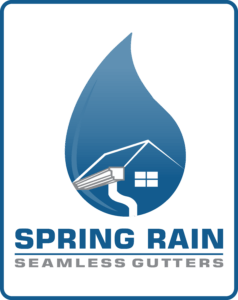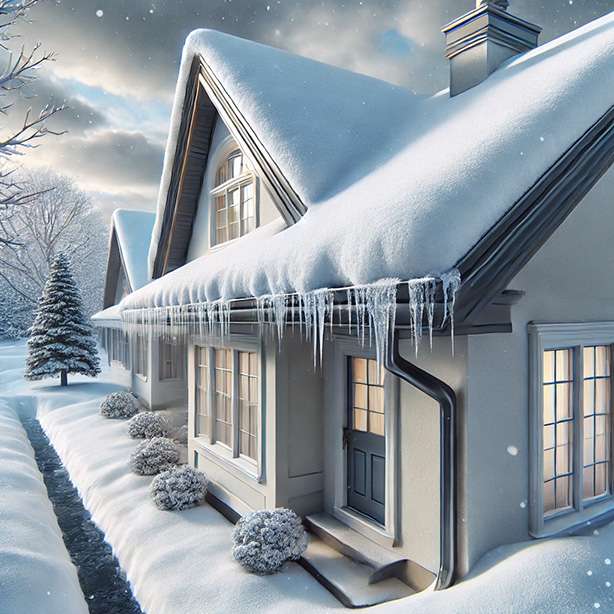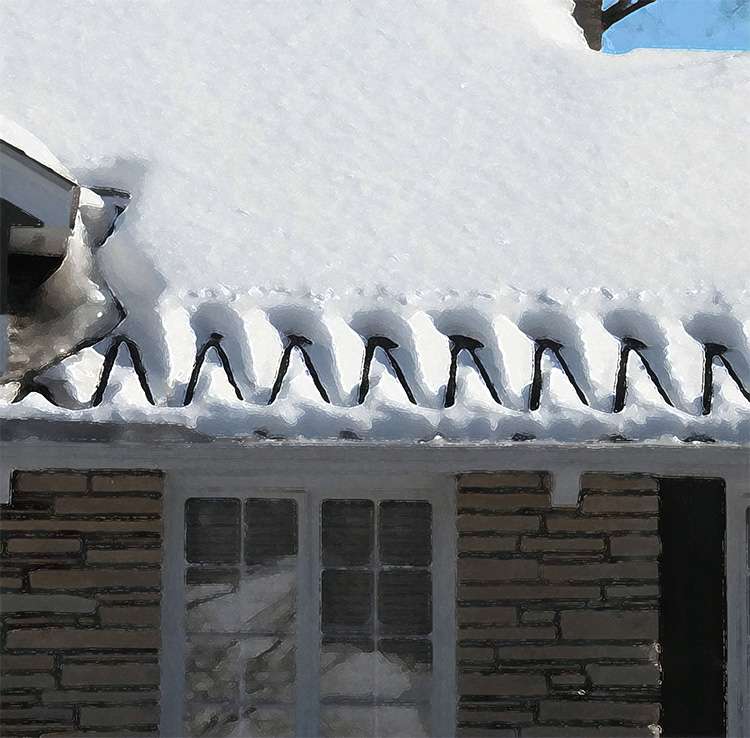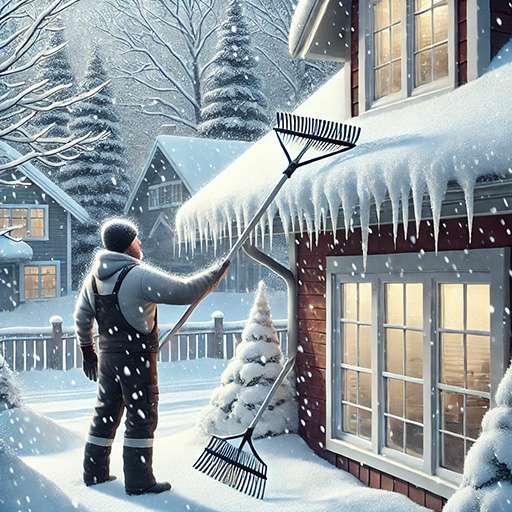When winter arrives, so do ice-related problems for roofs and gutters. Ice dams, in particular, are a big concern for homeowners in colder climates. These frozen barriers can cause water to back up on the roof, leading to leaks, roof damage, and even structural issues. As temperatures drop, many wonder if gutters can help prevent these costly ice dams—or if they might make the problem worse.
In this article, we’ll explore what ice dams are, what causes them, how gutters fit into the picture, and effective ways to protect your home from winter damage. Understanding these factors will help you prepare your gutters and roof for winter’s challenges.
What Are Ice Dams?
Ice dams are thick ridges of solid ice that form along the edge of a roof. They develop when the snow on a warmer part of the roof melts and flows down toward the eaves, where it refreezes because this area remains colder. As this process repeats, the ice builds up, creating a barrier, or “dam,” at the edge of the roof.
When an ice dam forms, it can prevent melting snow from draining off the roof. Instead, water pools behind the dam, eventually finding its way beneath shingles, into the roof structure, and sometimes even into the home’s interior. The damage from this process can be significant, leading to water leaks, insulation issues, and costly repairs.
Causes of Ice Dams
1. Uneven Roof Temperatures
- The primary cause of ice dams is an uneven roof temperature. When warm air rises from inside the home into the attic, it heats the upper part of the roof. Snow on this part melts and flows down to the cooler edge, where it refreezes.
- The consistent cycle of melting and refreezing leads to the gradual formation of ice dams.
2. Poor Insulation and Ventilation
- If an attic lacks proper insulation or ventilation, warm air from the home can accumulate, raising the temperature of the roof surface. This can happen in older homes with minimal insulation or in any home with a poorly ventilated attic.
- Adequate insulation helps keep the heat inside your home rather than warming the roof, while good ventilation helps maintain a consistent, colder temperature across the roof surface, minimizing the risk of melting snow and ice dams.
-
How Gutters Play a Role in Ice Dam Formation
Gutters are essential for directing water away from a home’s roof and foundation, but they can also play a role in ice dam formation—both positively and negatively.
1. Water Management
- Properly functioning gutters collect melting snow and rain, directing it safely away from the home’s foundation. When clear of debris, gutters allow water to flow freely, reducing the likelihood of ice forming.

2. Clogged Gutters and Ice Formation
- When gutters are clogged, water can back up and freeze along the roof’s edge. This ice buildup can contribute to ice dams, as the gutters provide a location for ice to accumulate.
- In some cases, this backup can result in ice creeping under shingles and into the roof structure, causing damage.
3. Gutters and Icicles
- As melting snow flows down, it may drip over the edge of a clogged gutter, freezing into icicles. These icicles not only add extra weight to the gutter system but also signal that ice dams may be forming.
When maintained and clear, gutters are more likely to help rather than hinder. However, it’s essential to consider additional solutions beyond gutters alone in winter conditions where ice dams are common..
Can Gutters Prevent Ice Dams?
While gutters aren’t a guaranteed solution for ice dams, they can help if used correctly. The key is to prepare them and enhance them with additional winter-resistant systems.
1. Regular Gutter Maintenance
- Clean gutters are less likely to contribute to ice dams. Make sure to clear leaves, twigs, and other debris from the gutters before winter hits. Installing gutter guards can also help keep debris out.

2. Heated Gutter Systems
- Heated gutters, equipped with heating elements or heat cables, can help melt ice and snow before it has a chance to freeze. These systems are especially helpful in preventing ice buildup along the roof’s edge, reducing the conditions contributing to ice dams. Heated systems work by maintaining a consistent temperature within the gutters, allowing water to flow freely even in colder conditions.
- Heated systems work by maintaining a consistent temperature within the gutters, allowing water to flow freely even in colder conditions.
3. Sloped Gutters for Optimal Drainage
- Gutters should have a slight slope to efficiently direct water toward downspouts. This setup reduces the likelihood of water pooling and freezing, as water can quickly exit the system.
Benefits of Heated Gutters for Ice Dam Prevention
Installing a heated gutter system can be a significant investment, but it offers several benefits for homeowners in icy climates:
1. Prevents Ice Buildup
- Heated gutters help prevent ice buildup by melting snow and ice as it comes into contact with the gutter. This prevents large icicles from forming and reduces the weight load on your gutters.
2. Reduces Gutter Damage
- By preventing the accumulation of heavy ice, heated gutters protect the structural integrity of your gutter system, reducing the risk of sagging, bending, or cracking under the weight of ice.
3. Improves Water Flow
- Heated systems ensure that water flows freely through the gutters, reducing the risk of backups and ice dams. This can help prevent water from seeping under shingles and causing leaks.
Maintenance Tips to Prepare Gutters for Winter
Regular maintenance is essential to keep gutters effective against ice dams. Here are some tips for winter preparation:1. Clean Out Gutters Before Winter
- Remove all debris from gutters to ensure water flows smoothly. Blockages can freeze, creating a base for further ice formation.
2. Inspect Gutters for Damage
- Look for sagging, cracks, or leaks in the gutter system. Damaged areas can worsen under the weight of ice, leading to additional repair needs.
3. Install Gutter Guards
- Gutter guards help keep leaves and twigs out, reducing the need for frequent cleaning. This ensures water can drain easily, even after a snowfall.
4. Consider Heated Cables for High-Risk Areas
- Heated cables can be installed along the roof edge and gutters to prevent freezing. These cables work especially well in areas prone to heavy snowfall and ice buildup.
Other Solutions to Prevent Ice Dams (Beyond Gutters)
In addition to maintaining gutters, there are several other effective solutions to combat ice dams:1. Improve Attic Insulation
- Improving insulation can keep warm air from escaping into the attic, reducing roof temperature fluctuations.
2. Ventilate the Attic
- Proper attic ventilation ensures that warm air doesn’t accumulate in one place, keeping the roof consistently cool to minimize snow melt.
3. Remove Snow Buildup
- Use a roof rake to remove heavy snow from the roof. This prevents excessive snow from accumulating and melting on warm sections of the roof.
4. Install Heat Cables on the Roof Edge
- In areas with persistent ice dam problems, heating cables along the roof edge can provide extra protection, preventing ice from building up.

Signs That Ice Dams Are Causing Gutter or Roof Damage
Homeowners should watch for these warning signs of ice dam damage:1. Water Stains or Leaks Inside the Home
- Water stains on walls or ceilings can indicate ice dams are causing water to seep through the roof.
2. Visible Roof Damage
- Curling shingles, missing tiles, or sagging areas on the roof can all be signs that ice dams are causing harm.
3. Sagging Gutters
- If your gutters look uneven or are sagging, this could indicate they’re bearing extra weight from ice buildup.
4. Large Icicles
- While small icicles are common, large icicles along the edge of the roof may suggest that water is backing up due to an ice dam.
When to Call a Professional for Ice Dam Prevention and Gutter Help
Some ice dam solutions, like installing heated gutters or adding roof insulation, are best handled by professionals. Here’s when to call for help:1. Persistent Ice Dams
- If ice dams occur every winter, professionals can assess the root cause and suggest insulation, ventilation, or gutter upgrades.
2. Visible Damage
- Contact a contractor if you notice signs of roof or gutter damage, as addressing these issues can prevent further costs.
Conclusion
While gutters alone may not prevent ice dams, they play a crucial role in managing water flow and minimizing ice buildup when properly maintained. Heated gutter systems and regular cleaning can help prevent water backup, reducing the risk of ice dams. Additionally, investing in attic insulation, ventilation, and snow removal strategies will further protect your home.
By taking these preventative steps, you can keep your home safe, dry, and protected from winter’s icy hazards. At Spring Rain Gutters, we’re here to help you prepare for the season. Contact us today for expert gutter maintenance and installation or to learn more about winter-ready solutions. You’ll enjoy a worry-free season with the right gutter care and winter preparedness!
References
“Preventing Roof Ice Dama”– National Weather Service
“Ice Dam Myth: Gutters Cause Ice Dams”– Ice Dam Guys
“Winter Warning” Are Your Gutters Contributing to Ice Dams?– Red Diamond Roofing



